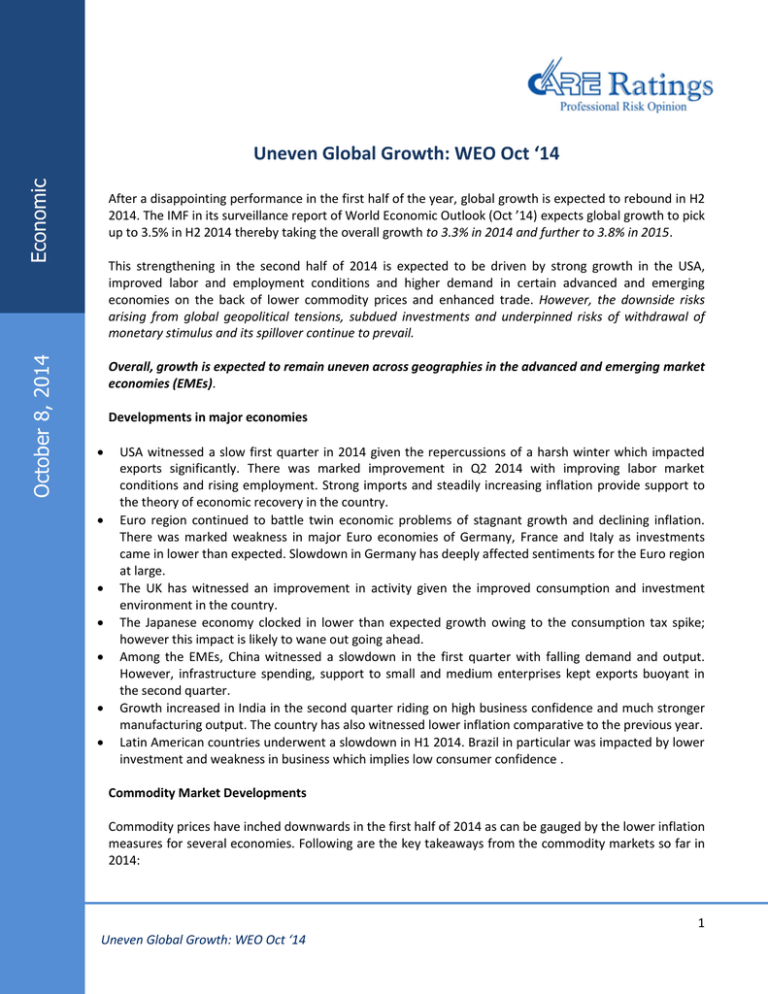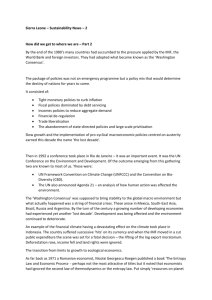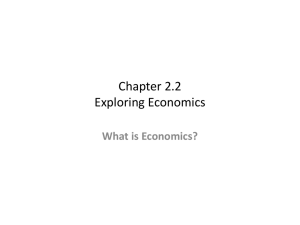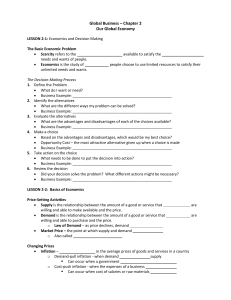Uneven Global Growth: WEO Oct ‘14 ic m
advertisement

October 8, 2014 Economic Uneven Global Growth: WEO Oct ‘14 After a disappointing performance in the first half of the year, global growth is expected to rebound in H2 2014. The IMF in its surveillance report of World Economic Outlook (Oct ’14) expects global growth to pick up to 3.5% in H2 2014 thereby taking the overall growth to 3.3% in 2014 and further to 3.8% in 2015. This strengthening in the second half of 2014 is expected to be driven by strong growth in the USA, improved labor and employment conditions and higher demand in certain advanced and emerging economies on the back of lower commodity prices and enhanced trade. However, the downside risks arising from global geopolitical tensions, subdued investments and underpinned risks of withdrawal of monetary stimulus and its spillover continue to prevail. Overall, growth is expected to remain uneven across geographies in the advanced and emerging market economies (EMEs). Developments in major economies USA witnessed a slow first quarter in 2014 given the repercussions of a harsh winter which impacted exports significantly. There was marked improvement in Q2 2014 with improving labor market conditions and rising employment. Strong imports and steadily increasing inflation provide support to the theory of economic recovery in the country. Euro region continued to battle twin economic problems of stagnant growth and declining inflation. There was marked weakness in major Euro economies of Germany, France and Italy as investments came in lower than expected. Slowdown in Germany has deeply affected sentiments for the Euro region at large. The UK has witnessed an improvement in activity given the improved consumption and investment environment in the country. The Japanese economy clocked in lower than expected growth owing to the consumption tax spike; however this impact is likely to wane out going ahead. Among the EMEs, China witnessed a slowdown in the first quarter with falling demand and output. However, infrastructure spending, support to small and medium enterprises kept exports buoyant in the second quarter. Growth increased in India in the second quarter riding on high business confidence and much stronger manufacturing output. The country has also witnessed lower inflation comparative to the previous year. Latin American countries underwent a slowdown in H1 2014. Brazil in particular was impacted by lower investment and weakness in business which implies low consumer confidence . Commodity Market Developments Commodity prices have inched downwards in the first half of 2014 as can be gauged by the lower inflation measures for several economies. Following are the key takeaways from the commodity markets so far in 2014: 1 Uneven Global Growth: WEO Oct ‘14 Economics There were some major disruptions in crude oil supplies which touched a high of excess of 3 million barrels per day with the highest such disruptions recorded in Libya, Syria and Iraq due to domestic factors. However, notwithstanding these disruptions, oil prices continued to move downwards which thereby suggests a high supply from the non OPEC countries and also a continuous high production in some OPEC countries with surplus capacity. There are upside risks to oil prices as is the case always given the possible supply outrages and geopolitical tension. Owing to favorable weather conditions so far in 2014, food prices have slid down by 9% since March ‘14. Food prices are estimated to remain steady with a downward bias given the lower probability of El Nino conditions, higher food stock and bumper crops for cereal and oilseeds. Metal prices have fallen in recent times on the back of lower inventories for some metals. However, there is an overall excess supply which implies that prices might remain lower in 2014. Growth Prospects of major economies The table below captures the GDP projections by the IMF for 2014 and 2015 for select economies. Table 1: GDP Projections (%) 2012 Country World Advanced Economies USA Euro Area UK Germany France Italy Japan Canada Emerging Market and Developing Economies China India* ASEAN South Africa Russia Brazil Mexico Source: WEO (IMF) 2013 3.4 1.2 2.3 -0.7 0.3 0.9 0.3 -2.4 1.5 1.7 5.1 7.7 4.7 6.2 2.5 3.4 1.0 4.0 2014 3.3 1.4 2.2 -0.4 1.7 0.5 0.3 -1.9 1.5 2.0 4.7 7.7 5.0 5.2 1.9 1.3 2.5 1.1 2015 3.3 1.8 2.2 0.8 3.2 1.4 0.4 -0.2 0.9 2.3 4.4 7.4 5.6 4.7 1.4 0.2 0.3 2.4 3.8 2.3 3.1 1.3 2.7 1.5 1.0 0.8 0.8 2.4 5.0 7.1 6.4 5.4 2.3 0.5 1.4 3.5 *for fiscal years at market prices. Growth rates at factor cost are 4.5% in FY13, 4.7% in FY15, 5.6% in FY15 and 6.4% in FY16 Global growth is likely to rebound driven by the growth in the US and some emerging market economies. The USA is slated to be the world leader for growth while also providing the required boost to EMEs on the back of healthy financial conditions, easy monetary policy stance, employment growth, all of which have together translated into healthier household balance sheets and thereby caused consumer demand to rise. 2 Uneven Global Growth: WEO Oct ‘14 Economics Weak recovery is the path expected for the Euro region going ahead which is to be supported by reduction in fiscal drag, gradually improving lending conditions and a continued accommodative monetary policy. Growth is to remain uneven within the region with Spain forecast to witness an improvement while, Italy, France and Germany are expected to grow slower than earlier projections. As the after effects of the consumption tax hike fade out, Japanese growth is expected to resurrect driven by anticipation of higher private investments. UK is forecast to remain on the growth path as better credit and financial market conditions vouch for healthy corporate balance sheets. EMEs will grow modestly in H2 2014 riding on high domestic demand and increasing external demand even as certain structural impediments in key emerging economies are expected to be repaired. Continuing on the growth momentum of Q2 2014, China is expected to grow healthily in 2014 due to accelerated fiscal and infrastructure spending. India is to gain significantly from the higher investment and subsequently better exports which will more than compensate the poor monsoon in the country. Growth for the ASEAN group at large is estimated to be moderated from the previous projection in April ’14 owing to the slowdown in Thailand. Inflation Inflation has gravitated downwards in the first half of 2014 owing to the lower food and fuel prices. Further, major advanced economies have consistently recorded inflation below their respective Central Banks’ target (or range). This clearly points to an existing output gap in these countries. The US has seen some gradual rise in inflation as demand and output growth picked up in the second quarter of 2014. This trend is expected to continue as the country is likely to continue growing healthily. Inflation is a pressing concern in the Euro region in particular. An accommodative monetary policy to keep growth above its recent trend is required which the ECB has already ventured into. However, large output gap and weak credit conditions may continue to exert downward pressure on prices. Japan also recorded a rise in inflation even after delinking the impact of consumption tax on prices. Inflation in emerging economies has remained largely steady since April ’14 and is further likely to remain lower in 2014 relative to 2013 levels. Trade Most countries have witnessed a narrowing of current account imbalance in the first half of 2014 despite trade activity being lower. Trade growth was muted as economic growth overall appeared to be lower than initial expectations. However, global trade is estimated to pick up going ahead as GDP growth inches upwards. Exchange rates while being largely stable displayed a peculiar trend where the overvalued currencies recorded some depreciation and the undervalued currencies underwent appreciation. Risks As stated earlier in the report, global growth is expected to gain momentum in the second half of 2014. However, the downside risks to global growth have increased in recent times primarily owing to the high geopolitical threats emanating from the Middle East turmoil in Russia and Ukraine. Further, financial markets have been rising significantly thereby causing long term yields lower. Hence, there is an impending risk of a correction in financial markets. Certain specific threats to global growth are 3 Uneven Global Growth: WEO Oct ‘14 Economics Normalization of interest rates in the USA and its spill over across geographies. Deflation threat to the Euro zone. Low potential output growth in advanced and EMEs. Repercussions of geopolitical tensions on commodity prices. Where does India Stand? The growth prospects for India stand improved in October ’14 as compared with April ’14. The IMF revised India’s growth forecast from 5.4% to 5.6% in 2014 while retaining the forecast for 2015 at 6.4%. After the establishment of the new government, there has subsequently been an optimistic business and investment sentiments. Production has increased from year ago levels and inflation has recorded a deceleration. Going ahead, healthy investment inflows into the country, higher domestic demand and improved external demand will continue to spur production and subsequently exports in H2 2014. Contact: Madan Sabnavis Chief Economist madan.sabnavis@careratings.com 91-022-67543489 Garima Mehta Associate Economist garima.mehta@careratings.com 91-022-61443526 Disclaimer This report is prepared by the Economics Division of Credit Analysis &Research Limited [CARE]. CARE has taken utmost care to ensure accuracy and objectivity while developing this report based on information available in public domain. However, neither the accuracy nor completeness of information contained in this report is guaranteed. CARE is not responsible for any errors or omissions in analysis/inferences/views or for results obtained from the use of information contained in this report and especially states that CARE (including all divisions) has no financial liability whatsoever to the user of this report. 4 Uneven Global Growth: WEO Oct ‘14






